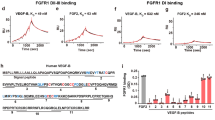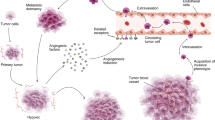Abstract
Inhibition of αvβ3 or αvβ5 integrin function has been reported to suppress neovascularization and tumor growth, suggesting that these integrins are critical modulators of angiogenesis. Here we report that mice lacking β3 integrins or both β3 and β5 integrins not only support tumorigenesis, but have enhanced tumor growth as well. Moreover, the tumors in these integrin-deficient mice display enhanced angiogenesis, strongly suggesting that neither β3 nor β5 integrins are essential for neovascularization. We also observed that angiogenic responses to hypoxia and vascular endothelial growth factor (VEGF) are augmented significantly in the absence of β3 integrins. We found no evidence that the expression or functions of other integrins were altered as a consequence of the β3 deficiency, but we did observe elevated levels of VEGF receptor-2 (also called Flk-1) in β3-null endothelial cells. These data indicate that αvβ3 and αvβ5 integrins are not essential for vascular development or pathological angiogenesis and highlight the need for further evaluation of the mechanisms of action of αv-integrin antagonists in anti-angiogenic therapeutics.
This is a preview of subscription content, access via your institution
Access options
Subscribe to this journal
Receive 12 print issues and online access
$209.00 per year
only $17.42 per issue
Buy this article
- Purchase on Springer Link
- Instant access to full article PDF
Prices may be subject to local taxes which are calculated during checkout






Similar content being viewed by others
References
Ferrara, N. & Alitalo, K. Clinical applications of angiogenic growth factors and their inhibitors. Nature Med. 5, 1359–1364 (1999).
Hynes, R.O., Bader, B.L. & Hodivala-Dilke, K. Integrins in vascular development. Braz. J. Med. Biol. Res. 32, 501–510 (1999).
Carmeliet, P. & Jain, R.K. Angiogenesis in cancer and other diseases. Nature 407, 249–257 (2000).
Carmeliet, P. et al. Abnormal blood vessel development and lethality in embryos lacking a single VEGF allele. Nature 380, 435–439 (1996).
Shalaby, F. et al. Failure of blood-island formation and vasculogenesis in Flk-1-deficient mice. Nature 376, 62–66 (1995).
Fong, G.H., Rossant, J., Gertsenstein, M. & Breitman, M.L. Role of the Flt-1 receptor tyrosine kinase in regulating the assembly of vascular endothelium. Nature 376, 66–70 (1995).
Brekken, R.A. et al. Selective inhibition of vascular endothelial growth factor (VEGF) receptor 2 (KDR/Flk-1) activity by a monoclonal anti-VEGF antibody blocks tumor growth in mice. Cancer Res. 60, 5117–5124 (2000).
Saaristo, A., Karpanen, T. & Alitalo, K. Mechanisms of angiogenesis and their use in the inhibition of tumor growth and metastasis. Oncogene 19, 6122–6129 (2000).
Senger, D.R. et al. Angiogenesis promoted by vascular endothelial growth factor: Regulation through α1β1 and α2β1 integrins. Proc. Natl. Acad. Sci. USA 94, 13612–13617 (1997).
Kim, S., Harris, M. & Varner, J.A. Regulation of Integrin αvβ3-mediated Endothelial Cell Migration and Angiogenesis by Integrin α5β1 and protein kinase A. J. Biol. Chem. 275, 33920–33928 (2000a).
Brooks, P.C., Clark, R.A.F. & Cheresh, D.A. Requirement of vascular integrin αvβ3 for angiogenesis. Science 264, 569–571 (1994).
Brooks, P.C. et al. Integrin αvβ3 antagonists promote tumor regression by inducing apoptosis angiogenic blood vessels. Cell 79, 1157–1164 (1994).
Brooks, P.C. et al. Antiintegrin αvβ3 blocks human breast-cancer growth and angiogenesis in human skin. J. Clin. Invest. 96, 1815–1822 (1995).
Drake, C.J., Cheresh, D.A. & Little, C.D. An antagonist of integrin αvβ3 prevents maturation of blood vessels during embryonic neovascularization. J. Cell Sci. 108, 2655–2661 (1995).
Friedlander, M. et al. Definition of two angiogenic pathways by distinct αv integrins. Science 270, 1500–1502 (1995).
Friedlander, M. et al. Involvement of integrins αvβ3 and αvβ5 in ocular neovascular diseases. Proc. Natl. Acad. Sci. USA 93, 9764–9769 (1996).
Eliceiri, B.P. & Cheresh, D.A. The role of αv integrins during angiogenesis: Insights into potential mechanisms of action and clinical development. J. Clin. Invest. 103, 1227–1230 (1999).
Varner, J.A. & Cheresh, D.A. Integrins and cancer. Curr. Opin. Cell Biol. 8, 724–730 (1996).
Hammes, H.P., Brownlee, M., Jonczyk, A., Sutter, A. & Preissner, K.T. Subcutaneous injection of a cyclic peptide antagonist of vitronectin receptor-type integrins inhibits retinal neovascularization. Nature Med. 2, 820–820 (1996).
Kumar, C.C. et al. Inhibition of angiogenesis and tumor growth by SCH221153, a dual αvβ3 and αvβ5 integrin receptor antagonist. Cancer Res. 61, 2232–2238 (2001).
Gutheil, J.C. et al. Targeted antiangiogenic therapy for cancer using vitaxin: A humanized monoclonal antibody to the integrin αvβ3 . Clin. Cancer Res. 6, 3056–3061 (2000).
Bader, B.L., Rayburn, H., Crowley, D. & Hynes, R.O. Extensive vasculogenesis, angiogensis, and organogenesis precede lethality in mice lacking all αv integrins. Cell 95, 507–519 (1998).
Hodivala-Dilke, K.M. et al. β3-integrin-deficient mice are a model for Glanzmann thrombasthenia showing placental defects and reduced survival. J. Clin. Invest. 103, 229–238 (1999).
Huang, X.Z., Griffiths, M., Wu, J.F., Farese, R.V. & Sheppard, D. Normal development, wound healing, and adenovirus susceptibility in β5-deficient mice. Mol. Cell. Biol. 20, 755–759 (2000).
Kim, S., Bell, K., Mouse, S.A. & Varner, J.A. Regulation of angiogenesis in vivo by ligation of integrin α5β1 with the central cell-binding domain of fibronectin. Am. J. Pathol. 156, 1345–1362 (2000b).
Pierce, E.A. Regulation of vascular endothelial growth factor by oxygen in a model of retinopathy of prematurity (vol 114, pg 1219, 1996). Arch. Ophthalmol. 115, 427–427 (1997).
Stone, E.M. & Sheffield, V.C. Genetic approaches to human retinal disorders. Invest. Ophthalmol. Vis. Sci. 37, 3100–3100 (1996).
Kroon, M.E., Koolwijk, P., van der Vecht, B. & van Hinsbergh, V.W.M. Urokinase receptor expression on human microvascular endothelial cells is increased by hypoxia: Implications for capillary-like tube formation in a fibrin matrix. Blood 96, 2775–2783 (2000).
DiazGonzalez, F., Forsyth, J., Steiner, B. & Ginsberg, M.H. Trans-dominant inhibition of integrin function. Mol. Biol. Cell 7, 1939–1951 (1996).
Blystone, S.D., Graham, I.L., Lindberg, F.P. & Brown, E.J. Integrin αvβ3 differentially regulates adhesive and phagocytic functions of the fibronectin receptor α5β1 . J. Cell Biol 127, 1129–1137 (1994).
Huhtala, P. et al. Cooperative signalling by α5β1 and α4β1 integrins regulates metalloproteinase gene expression in fibroblasts adhering to fibronectin. J. Cell Biol 129, 876–879 (1995).
Chen, Y. et al. “Inside out” signal transduction inhibited by isolated integrin cytoplasmic domains. J. Biol. Chem. 269, 18307–18310 (1994).
LaFlamme, S.E., Thomas, L.A., Yamada, S.S. & Yamada, K.M. Single subunit chimeric integrins as mimics and inhibitors of endogenous integrin functions in receptor localization, cell spreading and migration, and matrix assembly. J. Cell Biol. 126, 1287–1298 (1994).
Taverna, D. & Hynes, R.O. Reduced blood vessel formation and tumor growth in α5-integrin-negative teratocarcinomas and embryoid bodies. Cancer Res. 61, 5255–5261 (2001).
Asahara, T. et al. VEGF contributes to postnatal neovascularization by mobilizing bone marrow-derived endothelial progenitor cells. EMBO J 18, 3964–3972 (1999).
Isner, J.M. & Asahara, T. Angiogenesis and vasculogenesis as therapeutic strategies for postnatal neovascularization. J. Clin. Invest. 103, 1231–1236 (1999).
Kalka, C. et al. Transplantation of ex vivo expanded endothelial progenitor cells for therapeutic neovascularization. Proc. Natl. Acad. Sci. USA 97, 3422–3427 (2000).
Takahashi, T. et al. Ischemia- and cytokine-induced mobilization of bone marrow–derived endothelial progenitor cells for neovascularization. Nature Med. 5, 434–438 (1999).
Carmeliet, P. et al. Synergism between vascular endothelial growth factor and placental growth factor contributs to angiogenesis and plasma extravasation in pathological conditions. Nature Med. 7, 575–583 (2001).
Soldi, R. et al. Role of αvβ3 integrin in the activation of vascular endothelial growth factor receptor-2. EMBO J. 18, 882–892 (1999).
Byzova, T.V. et al. A mechanism for modulation of cellular responses to VEGF: Activation of the integrins. Mol. Cell 6, 851–860 (2000).
Marcantonio, E. & Hynes, R. Antibodies to the conserved cytoplasmic domain of the integrin β1 subunit react with proteins in vertebrates, invertebrates, and fungi. J. Cell Biol. 106, 1765–1772 (1988).
Albrecht-Buehler, G. The phagokinectic tracks of 3T3 Cells. Cell 11, 395–404 (1977).
Passaniti, A. et al. A simple, quantitative method for assessing angiogenesis and antiangiogenic agents using reconstituted basement membrane, heparin, and fibroblast growth factor. Lab. Invest. 67, 519–528 (1992).
Nicosia, R.F. & Ottinetti, A. Modulation of microvascular growth and morphogenesis by reconstituted basement-membrane gel in 3-dimensional cultures of rat aorta—a comparative-study of angiogenesis in Matrigel, collagen, fibrin, and plasma clot. In Vitro Cell. Dev. Biol. 26, 119–128 (1990).
Acknowledgements
We thank B. Coller, E. Ruoslahti and L. Reichardt for antibodies against mouse β3-, αv and β5 integrin antibodies, respectively; G. Saunders, S. Watling and C. Wren for their technical assistance; G. Elias and colleagues for help with histology; J. Marshall for his gift of human β3-construct; F. Parkinson for her help in preparing the manuscript; and I. Hart for criticism during this study. This work was supported in part by grants from the NIH (PO1HL41484, PO1HL66105 and RO1CA17007 to R.O.H. and R01 HL64353, RO1 HL53949 to D.S.), and by the Howard Hughes Medical Institute. R.O.H. is an investigator and D.T. is an Associate of the Howard Hughes Medical Institute.
Author information
Authors and Affiliations
Corresponding author
Rights and permissions
About this article
Cite this article
Reynolds, L., Wyder, L., Lively, J. et al. Enhanced pathological angiogenesis in mice lacking β3 integrin or β3 and β5 integrins. Nat Med 8, 27–34 (2002). https://doi.org/10.1038/nm0102-27
Received:
Accepted:
Issue Date:
DOI: https://doi.org/10.1038/nm0102-27
This article is cited by
-
Integrin α3β1 promotes vessel formation of glioblastoma-associated endothelial cells through calcium-mediated macropinocytosis and lysosomal exocytosis
Nature Communications (2022)
-
Noninvasive photoacoustic computed tomography/ultrasound imaging to identify high-risk atherosclerotic plaques
European Journal of Nuclear Medicine and Molecular Imaging (2022)
-
Integrins regulate stemness in solid tumor: an emerging therapeutic target
Journal of Hematology & Oncology (2021)
-
There is a world beyond αvβ3-integrin: Multimeric ligands for imaging of the integrin subtypes αvβ6, αvβ8, αvβ3, and α5β1 by positron emission tomography
EJNMMI Research (2021)
-
Compensatory increase of VE-cadherin expression through ETS1 regulates endothelial barrier function in response to TNFα
Cellular and Molecular Life Sciences (2020)



